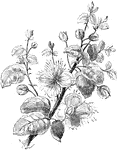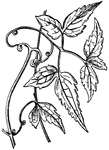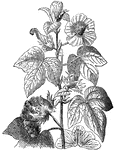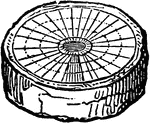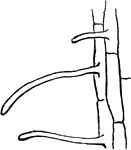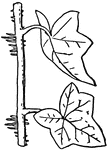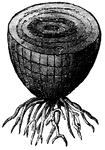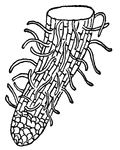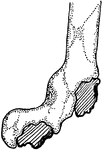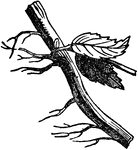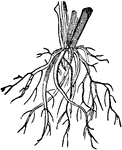The Stems and Roots ClipArt gallery provides 112 illustrations of the various types of stem and root structures in plants.

Tubers of Anemone Coronaria
Anemone coronaria has tuberous roots. The flowers grow up to one foot tall from the roots

Cross Section of Stem of Bignonia
Illustrated is the cross section of a stem of a tropical climber of the bignonia family. The stem is…
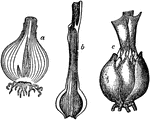
Various Bulbs
"a.-- Truncated bulb of onion; b.-- onion leaf dissected off; c.-- bulb of lily. Bulb, a modified leaf-bud,…
Sugar Cane
A sugar cane stem. A are buds or eyes, B are joints, C are nodes, D are internodes, and X are dots where…
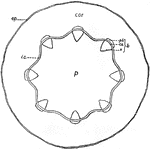
Castor-Oil Plant Stem
"Diagram showing tissue-systems in young stem of castor-oil plant (Ricinus communis), as seen in cross-section.…

Cutting Radially
"Showing the planes in which sections are cut longitudinal radially" -Stevens, 1916
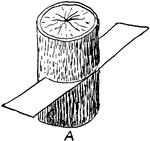
Cutting Sections Transversely
"Showing the planes in which sections are cut transversely." -Stevens, 1916
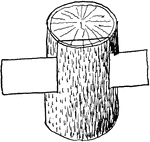
Cutting Tangentially
"Showing the planes in which sections are cut longitudinal tangentially." -Stevens, 1916

Section of Branch Showing Exogen
"Exogen. 1. Section of a branch of three years' growth: a, medulla or pith; b b, medullary sheath; e…

Ginger
Ginger is the dried rhizome of the tropical plant Zingiber officinale. It is used in cookery, because…

Hedge Garlic
Hedge Garlic (Sisymbrium Allaria). A, Inflorescence and Cauline Leaves. B, Radical Leaf and Root.
Juncus Conglomeratus
Juncus conglomeratus, also known as the common rush, belongs to a genus of grass-like herbs (Juncus)…

Juncus Effusus
Known as the soft rush, Juncus effusus is nearly as common as the most common species, J. conglomeratus.…

Jute
Jute, also known as Calcutta Hemp, is a fiber obtained from several species of the genus Corchorus of…
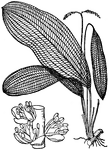
Lattice Leaf
Lattice Leaf is the popular name of a water plant, 'Aponogeton jenestralis', belonging to the order…
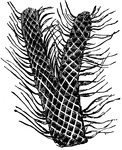
Portion of Lepidodendron
This illustration shows a portion of Lepidodendron. Lepidodendron is the generic name of a large and…
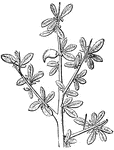
Myrrh
Myrrh, found in the old testament of the bible as one of the three gifts given to Jesus on the day of…

Palm-stem
A Palm-stem in transverse and longitudinal section, the dots on the cross sections represent cut ends…

Plant Tissues
"Diagram showing the relation of this year's leaves to the wood of the current year." -Stevens, 1916

Radish - Spindle-Shaped Root
Raphanus sativus. Illustration of a radish root. The root is spindle-shaped.
Root
Roots aid in support and nutrition for the plant. This is a runner root which sends down roots into…

Plant Root Hair
"A single root hair on a large scale, showing that it is an outgrowth of an epidermal cell, and the…

Root Pressure
"Apparatus to measure root-pressure. T, large tube fastened to the stump of the dahlia stem by a rubber…

Root Vessels
"Laticiferous vessels from the cortex of root of Scorozonora hispanica...B, smaller portion." -Stevens,…

A. Ascalonicum Root
"Portion of a cross section of a root of Allium ascalonicum. h, large central, tracheal tube; i, xylem,…

Branching Root
"These roots are such as subdivide in the earth in a manner similar to the divisions of the stem, and…
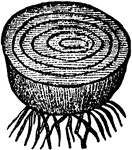
Bulb Root
"The bulb is a leaf-bud inclosed in scales or concentric layers, and is found either at the base of…
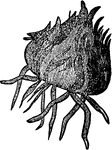
Cormus Root
"The Cormus is that variety which increases beneath the earth by development of buds in the axils of…
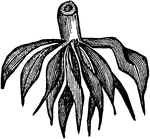
Fasciculated Root
"When the fibers of roots become enlarged by the deposition of starch, they form this variety of root."—Darby,…

Fibrous Root
"This variety consists of numerous fibers proceeding from the neck of the plant, and may be seen in…

Napiform Root
"The variety which is very large at the base, but tapers abruptly, as in the Turnip."—Darby, 1855
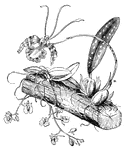
Orchid Root
Roots which never reach the ground are produced by certain plants whose seeds, lodged upon the boughs…

Rhizoma Root
"The Rhizoma or Rootstock grows in a nearly horizontal direction, emitting roots from its under side,…


